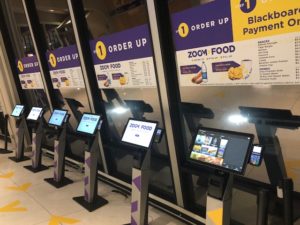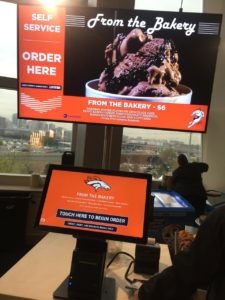
Appetize self-serve concession kiosks at LSU. Credit: Appetize (click on any picture for a larger image)
Some recent news and analysis from two of the top operators in the venue concessions point-of-sale systems arena — Oracle Food and Beverage and Appetize — offers some positive proof points in concession kiosk use, with Appetize reporting higher and bigger sales at some of its customer sites for kiosks vs. human stands, while Oracle F&B (the new name for the company formerly known as Micros) has released a fan survey showing that 71 percent of interviewed fans said they’d use a self-service kiosk while at the game.
From where we sit here at Mobile Sports Report, more self-serve kiosks can’t arrive fast enough. While it’s interesting to sift through some of the replies to the Oracle survey, it doesn’t take any research to guess that if you offer fans a faster way to get concessions and get back to their seats, they’re going to be in favor of it. Likewise, while the sample size of results offered by Appetize is somewhat small (its percentage gains are based on install numbers of just a few stations in each of the venues it mentions), the hard data does show that kiosks can produce double-digit gains in per-order sizes, a goal appealing to any concession operation.
“There’s no stadium that doesn’t want more food and beverage money,” said Jeff Pinc, AVP of sales for Oracle’s Food and Beverage division, in a recent phone interview. Adding self-service kiosks, he said, is an easy decision for many venues since fans are “sort of demanding it.
“Fans see these systems already in use everywhere else, and they’re asking ‘how come they’re not here?’ ” Pinc said. For the stadium owner and operator, Pinc said the self-service systems have already established their worth in many fast-casual dining establishments, and the benefits should pass over to the sports venue world.
“Fast-casual has been doing this [self-service kiosks] for some time now and it’s known that the basket size (per order) gets bigger,” Pinc said. Digital kiosks, he added, can also be more efficient at upselling customers, something that human employees may forget to do.
LSU, AT&T Center see kiosk gains
Appetize’s news announcement said that the eight kiosks installed at LSU’s basketball arena, the Pete Maravich Assembly Center, produced a 16% increase in average order size and 25% more items per order compared to human-operated terminals at point of sale counters. At the San Antonio Spurs’ AT&T Center, an initial test in the stadium’s Rock & Brews location was positive and led to the installation of six of the Appetize “Interact” kiosks, where the stadium saw an 18 percent increase in order size.
“The Appetize Interact platform offers a modern and dynamic digital experience for guests while driving increased share of wallet for the business,” said Max Roper, co-founder and CEO at Appetize, in a prepared statement. “In the past six months, over 45% of our deployments have included self-service kiosks, and we expect this trend to continue as businesses require more automation and consumers desire a more frictionless experience.”Oracle’s Pinc, whose company uses its Simphony POS system to help enable all operations including kiosk support, said that small, proof-of-concept deployments are a good start for any stadium interested in kiosks, since there are real-world details that need to go along with the automated systems.
“There’s a lot of thought that needs to go into a kiosk install, from educating the customer to where you put it, to where you go to pick up the food,” Pinc said. “There’s a lot of trial and error.”
Last fall MSR did a profile on how the Seattle Seahawks were using the Clear system to speed up beer-line payments, and also did some hands-on driving at a self-service POS terminal at the Denver Broncos’ Bronco Stadium at Mile High, where a system developed by Centerplate and PingHD was used to let fans order from individual chef stations in the club-level food court. Though Centerplate is no longer the concessionaire at Mile High, it’s just another sign that self-service is increasing inside stadiums, which is good news for fans tired of waiting behind the guy ordering 20 different things.







